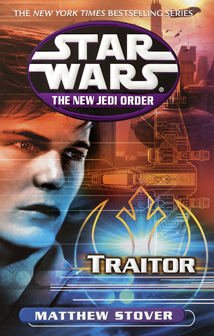There are two books in the “New Jedi Order” series that tripped up my reading flow on this re-read. The first is the ninth entry, “Star by Star,” because it’s relentlessly grim and overwritten. The second is the 13th book, “Traitor” (2002), because it’s so good that it can’t be read breezily; it demands that a reader take the time to savor the lyrical writing and profound lessons.
Matthew Stover’s first “Star Wars” book reinvigorates the “NJO” series with a less-is-more approach. The action initially takes place on a Yuuzhan Vong seed ship so far out in intergalactic space that the flat disc of the galaxy can be seen; it’s the perfect place for reshaping and re-examining Jacen Solo and the New Republic vs. Yuuzhan Vong conflict. Later, we move to the Vong-formed Coruscant — now called Yuuzhan’tar – and we experience the shock of familiar locations such as the Solo apartment and the Senate chamber having been taken over by teeming alien jungle life.
The need for a book that takes a deep breath and a step back came about when George Lucas decided Anakin Solo should be killed off in “Star by Star” rather than Jacen. (He didn’t want two Anakins running around in his universe, potentially confusing newcomers.) So now that his tragic death is off the table, Jacen presents a great opportunity for a character writer, and Stover runs with it. He metaphorically and literally strips down Jacen and builds him up again.
Previously an overthinker whose pacifism caused problems in the midst of battles, Jacen learns to think like a Yuuzhan Vong in “Traitor.” The title has a double meaning, because he appears to be a traitor to the New Republic, but in the end he turns on the Vong, who are beginning to revere him as a god. Through physical torture (Jacen is strapped to the Embrace of Pain) and psychological torture (he’s loosed in a Vong “nursery” where the slaves perform Sisyphean tasks), Jacen – and the reader — goes from abstractly understanding the Vong’s pain-based culture to more fully grasping their worldview. They view birth, life and death as having equal value. And while humans arbitrarily distinguish flowers from weeds, the Vong do the same thing on a larger scale – encompassing all living beings.
The subject matter is grim, but immensely readable thanks to Stover’s philosophizing and smart metaphors. “Traitor” is like a darker, more detailed expansion of Luke’s training with Yoda in “The Empire Strikes Back,” filled with lessons from Jacen’s teacher Vergere, a mysterious bird-like “pet” of the Vong who is ultimately revealed as yet another traitor, and a friend to Jacen.
The most controversial new perspective for many readers is Vergere’s – and Stover’s, no doubt – assertion that there is no dark side of the Force. (Aside from “Vector Prime,” which killed off Chewbacca, “Traitor” was the most hotly debated book of the “NJO” among fans.) Whereas “Star Wars” lore often speaks of Jedi falling to the dark side or being seduced by the dark side, Stover posits that the Force is simply a tool; it’s actually the individual who chooses of their own free will to do good or evil. To blame an outside natural force is to dodge one’s own responsibility. He also purports that the Jedi Order’s sense of the Force is limited by their “light vs. dark” obsession, and that’s why they are Force-blind to the Vong, a species that does seemingly evil things, but doesn’t draw on the Force to do so; rather, what the Jedi see as immoral (or “the dark side”) is moral from the Vong’s perspective.

I have no problem whatsoever with Stover’s perspective, because if the Force is “Star Wars’ ” equivalent of a religion (albeit one that allows for some scientific proofs), then there is room for different interpretations. After all, Obi-Wan himself said truth is dependent on one’s point of view. And truthfully, even Lucas’ works didn’t dodge the notion that Vader and Luke possessed individual decision-making agency amid the temptations of the dark side.
Densely philosophical it may be, but there’s not a wasted word in “Traitor.” Even the fight scenes are good, as Stover – a martial artist himself – provides entertaining descriptions of Jacen flipping a Vong into a field of vicious, juvenile amphistaffs and of Ganner Rhysode building a wall of Vong corpses as a bulwark.
In addition to reinventing Jacen, Stover also does good work with Ganner, who had been preoccupied with his own legend for much of his life but goes out as an unselfish hero in “Traitor.” Arguably, Stover portrays Ganner a bit more black-and-white than previous novels did – he had been turning a corner on his egotism already, if I recall — but I’ll forgive him because it doesn’t seem like there were grander plans for this Jedi. Many more Jedi were killed off in “Star by Star” – I have no hope of naming even half of them off the top of my head — but Stover’s attention to characterization makes the arc leading up to Ganner’s sacrifice much more memorable.
“Traitor” is the spiritual turning point of the “NJO” saga. Some major mysteries have been answered – from Vergere’s loyalty to the internal logic of Yuuzhan Vong culture to the reason why the Vong seem to not exist in the Force. But there’s still some juicy stuff ahead in the final six books (and those aforementioned answers might not be the complete answers). I’m particularly interested to see how friends and family react to this starkly re-invented version of Jacen. And while Jacen is armed with a valuable new perspective, the logistical question of how our heroes will defeat the invaders remains a big one.
“Traitor” is not just a great “NJO” entry or a great “Star Wars” novel but a great novel, period. It probably shouldn’t be read as a standalone, but it does often feel like a strong coming-of-age/journey-into-darkness yarn that should be appreciated on its own merits. We didn’t get too many EU novels that unashamedly aimed for an adult audience and ascended to this degree of literary value (Stover’s “Shatterpoint” and “Revenge of the Sith” novelization arguably achieve such a level, as well). Since the Disney takeover, it’s almost certain that we’ll never get another one.

